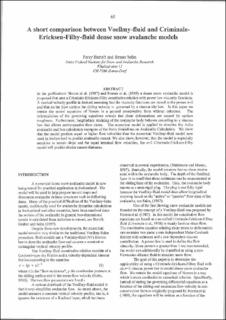| dc.contributor.author | Bartelt, Perry | |
| dc.contributor.author | Salm, Bruno | |
| dc.contributor.editor | Hestnes, Erik | |
| dc.date.accessioned | 2023-08-03T19:48:56Z | |
| dc.date.available | 2023-08-03T19:48:56Z | |
| dc.date.issued | 1998 | |
| dc.identifier.isbn | 82-546-0184-4 | |
| dc.identifier.issn | 0078-1193 | |
| dc.identifier.uri | https://hdl.handle.net/11250/3082549 | |
| dc.description.abstract | In the publications Norem et al. (1987) and Norem et al. (1989) a dense snow avalanche model is proposed that uses a Criminale-Ericksen-Filby constitutive relation with power law viscosity functions. A vertical velocity profile is derived assuming that the viscosity functions are raised to the power n=2 and that on the flow surface the sliding velocity is governed by a viscous slip law. In this paper we restate the model equations of Norem in a general conservative form without cohesion. The reformulation of the governing equations reveals that shear deformations are caused by surface roughness. Furthermore, longitudinal straining of the avalanche body behaves according to a viscous law that allows active-passive flow states. The numerical model is applied to simulate the Aulta avalanche and two calculation examples of the Swiss Guidelines on Avalanche Calculation. We show that the model predicts equal or higher flow velocities than the numerical Voellmy-fluid model now used in Switzerland to predict avalanche runout. We also show, however, that the model is especially sensitive to terrain slope and for equal terminal flow velocities, the n=2 Criminale-Ericksen-Filby model will predict shorter runout distances. | en_US |
| dc.language.iso | eng | en_US |
| dc.publisher | Norwegian Geotechnical Institute | en_US |
| dc.relation.ispartofseries | NGI Publication;203 | |
| dc.subject | Snow Avalanche | en_US |
| dc.subject | History | en_US |
| dc.subject | Avalanche-RnD | en_US |
| dc.subject | Snøskred-FoU | en_US |
| dc.title | A short comparison between Voellmy-fluid and Criminale-Ericksen-Filby-fluid dense snow avalanche models | en_US |
| dc.type | Chapter | en_US |
| dc.source.pagenumber | 65-69 | en_US |
